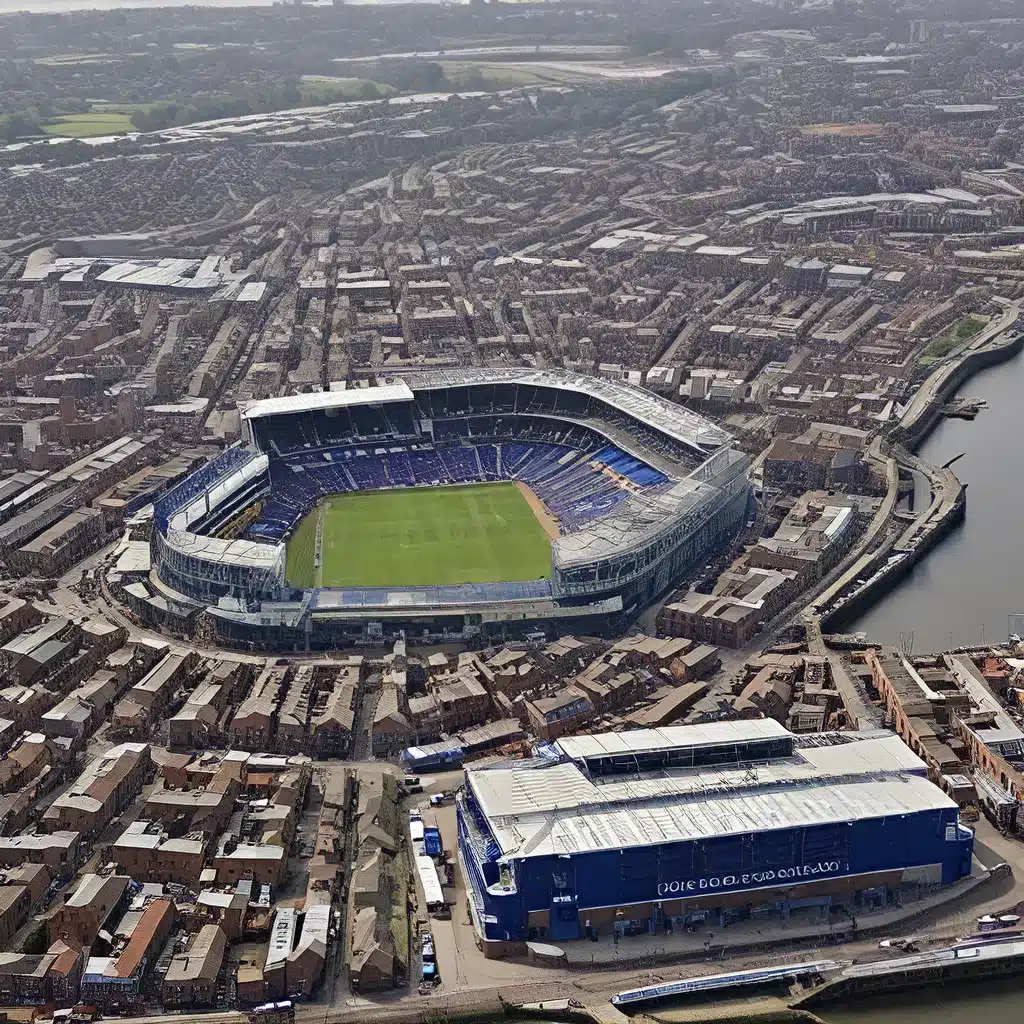
A Storied Past and Iconic Home of the Toffees
Nestled on the banks of the River Mersey, Goodison Park has been the home ground of Everton Football Club since its inception in 1892. This historic stadium has witnessed the triumphs and trials of one of England’s most celebrated clubs, serving as a beacon of passion and pride for the Toffees faithful. As Everton’s enduring fortress, Goodison Park has played a pivotal role in the club’s illustrious history, standing as a testament to the unwavering spirit of the Merseyside community.
The stadium’s origins trace back to 1882 when Everton was forced to leave their original home at Anfield due to a dispute with the ground’s owner, John Houlding. Determined to find a new venue, the club settled on a plot of land in the Walton district, which would become the site of the legendary Goodison Park. Designed by architect Archibald Leitch, the stadium’s construction was completed in 1892, marking the beginning of a remarkable journey that has spanned over a century.
Everton’s early years at Goodison Park were marked by their dominance on the domestic stage, winning multiple league titles and establishing themselves as one of the most formidable forces in English football. The stadium’s intimidating atmosphere and the unwavering support of the Toffees faithful played a crucial role in this success, with visiting teams often finding it challenging to overcome the team’s home advantage.
Architectural Elegance and Storied Stands
Goodison Park’s architectural design has evolved over the decades, with the stadium undergoing various renovations and expansions to accommodate the changing needs of the club and its supporters. The original Archibald Leitch-designed stands, characterized by their distinctive red-brick facades and ornate detailing, have become an iconic part of the stadium’s identity, evoking a sense of nostalgia and tradition among Everton fans.
One of the most notable features of Goodison Park is the towering Bullens Road Stand, which dominates the stadium’s skyline with its imposing presence. This stand, constructed in the 1930s, is renowned for its impressive Art Deco-inspired architecture, featuring a striking curved roof and a bold, linear aesthetic. The Bullens Road Stand has become an integral part of the Goodison Park experience, with its atmospheric terraces and commanding views of the pitch.
The Gwladys Street End, situated opposite the Bullens Road Stand, is another iconic feature of the stadium. This stand, which has undergone several renovations over the years, is renowned for its passionate and vocal supporters, who create a deafening atmosphere during matches. The Gwladys Street End has long been considered the heart of the Goodison Park experience, with its unwavering support and unwavering loyalty to the Toffees.
Enduring Memories and Moments of Glory
Throughout its illustrious history, Goodison Park has played host to countless memorable moments and historic events that have etched themselves into the collective consciousness of Everton fans. From the club’s domestic title triumphs to their European exploits, the stadium has witnessed the full spectrum of emotions, from the euphoric highs of victory to the heartbreaking lows of defeat.
One of the most iconic moments in Goodison Park’s history occurred in 1985, when Everton faced off against Juventus in the European Cup Winners’ Cup Final. Despite the tragic events at the Heysel Stadium just two weeks earlier, the Toffees were determined to honor the memory of those who lost their lives by delivering a performance worthy of the occasion. Though the match ended in disappointment for Everton, the unwavering support and resilience of the club’s supporters in the face of adversity has become the stuff of legend, cementing Goodison Park’s reputation as a fortress of unwavering loyalty and community spirit.
Another defining moment in Goodison Park’s history came in 1995, when Everton hosted their fierce rivals Liverpool in a highly anticipated Merseyside derby. In a match that encapsulated the intense rivalry between the two clubs, the Toffees emerged victorious, securing a memorable 1-0 win that sent the home supporters into a state of ecstasy. This triumph not only cemented Everton’s status as a formidable force in the region but also highlighted the stadium’s ability to provide a distinct home-field advantage for the club.
A Lasting Legacy and Future Challenges
As Everton Football Club continues to write new chapters in its storied history, Goodison Park remains an integral part of the team’s identity and the fabric of the Merseyside community. The stadium’s enduring legacy and the unwavering loyalty of its supporters have made it a cherished symbol of the club’s rich heritage and unwavering commitment to its roots.
However, as the demands of modern football continue to evolve, Everton faces the challenge of ensuring that Goodison Park remains a competitive and sustainable home for the club in the years to come. The club’s plans to build a new stadium in the nearby Bramley-Moore Dock area have been met with a mix of excitement and trepidation, as the future of the iconic Goodison Park remains uncertain.
Regardless of the outcome, one thing is clear: the legacy of Goodison Park and its place in Everton’s history will endure. The memories, the triumphs, and the unwavering support of the Toffees faithful will continue to inspire future generations of Evertonians, ensuring that the stadium’s enduring spirit lives on, even as the club navigates the challenges of the 21st century.

